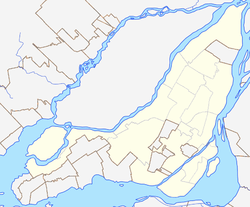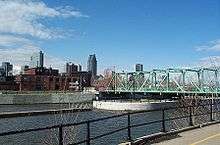Little Burgundy
| Little Burgundy La Petite-Bourgogne | |
|---|---|
| Neighbourhood | |
|
Edifice Georges Vanier | |
 Little Burgundy Location of Little Burgundy in Montreal | |
| Coordinates: 45°29′07″N 73°34′33″W / 45.485209°N 73.575954°WCoordinates: 45°29′07″N 73°34′33″W / 45.485209°N 73.575954°W | |
| Country | Canada |
| Province | Quebec |
| City | Montreal |
| Borough | Le Sud-Ouest |
| Established | 1864 |
| Population (2011)[1] | |
| • Total | 10,046 |

Little Burgundy (French: La Petite-Bourgogne) is a neighbourhood in the Sud-Ouest borough of the city of Montreal, Quebec, Canada.
Geography
Its approximate boundaries are Atwater Street to the west, Saint-Antoine to the north, Guy Street to the east, and the Lachine Canal to the south.
The adjacent neighbourhoods are the borough of Ville-Marie and downtown Montreal to the north and northeast, Griffintown to the southeast, Pointe-Saint-Charles to the south, and Saint-Henri to the west.
History
There are differing accounts of the origin of the name Little Burgundy (Petite-Bourgogne). A surveyor's map of 1855 identifies a property called Bourgogne, owned by the heirs of the Hon. Louis Guy (brother of Étienne Guy, for whom Guy Street was named). The property corresponds to the areas bounded today by Rue des Seigneurs, Rue Notre-Dame, Rue Saint-Martin, and Rue Saint-Antoine.[2]
Essentially agricultural until 1810, today's Little Burgundy began to be built up the ward of St. Joseph, a faubourg spreading outside the city walls. The area around Richmond Square was built up in 1819.[3]
Development accelerated in the mid-19th century with the construction of the Lachine Canal attracted many so-called "smokestack" industries, most notably the Canadian Pacific Railway yards, and the Steel Company of Canada (or Stelco) plant, among others. A residential sector was built north of the factories between 1857 and 1864. Originally part of the parish of Saint-Henri-des-Tanneries, it was set up as the village of Delisle in 1864,[4] then Sainte-Cunégonde in 1876, becoming a town in 1884.[5] The name derived from St. Cunigunde of Luxembourg, wife of St. Henry II, Holy Roman Emperor, a reference to the neighbouring parish.[6]
The industrial development along the Lachine Canal attracted many prestigious businesses to set up in the Ward of St. Joseph along Rue Notre-Dame, resulting in the construction of many handsome buildings which are the mainstay of today's antiques district.[7]
Starting in 1887, Little Burgundy came to acquire a unique niche as the home of Montreal's working-class English-speaking black community. Being located near Montreal's train stations, among the most important sites for the nascent trans-Canadian railway industry, Sainte-Cunégonde became home to a great many African-American workers from the United States and black Canadians from other provinces, as well as Caribbeans, who came to make up the majority of Montreal's black population.
Sainte-Cunégonde was absorbed into the city of Montreal in 1906; the former town hall is now a public library and community centre, located on Vinet Street. Sainte-Cunégonde was bounded by the Lachine Canal, Atwater Avenue, Dorchester Street (now Boul. René-Lévesque), and a straight line from the corner of Atwater and Tupper streets to the basin of the Lachine Canal just west of the St. Gabriel locks. Saint-Joseph Ward was bordered by that line, St. Antoine Street, Victoria Square, McGill Street, and Notre-Dame Street. At this time, the Grand Trunk Railway ran directly through the area, terminating at St. Bonaventure Station.[8]
To combat poverty and social exclusion, the nascent black community founded numerous social organizations: the Women’s Coloured Club of Montreal in 1902, the Union United Congregational Church in 1907, and the Negro Community Center in 1927.[9]
The neighbourhood became famous for producing several talented jazz musicians. During Prohibition and the later pre-Jean Drapeau years as an 'open city,' Little Burgundy was home to many lively nightclubs featuring homegrown and international performers; one of them was Rockhead's Paradise, owned by Rufus Rockhead, after whom a street is named. Oscar Peterson and Oliver Jones are the two best-known musicians who emerged from the bebop and post-bop era.[9]
Already hurt by the Great Depression before the war,[7] like the rest of the area around the Lachine Canal Little Burgundy was hit hard by the opening of the St. Lawrence Seaway in 1956 and the closure of the Lachine Canal in 1970; numerous industries left for the suburbs, leaving the area in a state of decay. In 1966, the city of Montreal launched a large urban renewal project in Little Burgundy, demolishing countless condemned dwellings and replacing them with social housing developments,[4] while revitalizing other parts of the neighbourhood.[5] The parts of the neighbourhood north of Rue Saint-Antoine were demolished in 1970 to make room for the Ville-Marie Expressway.[3]
The profile of the neighbourhood has changed significantly in recent years. In the 2006 census, black Canadians still constituted the largest visible minority population in the census tracts of Little Burgundy west of Rue Guy; but they constituted only 19% of the population of Little Burgundy. 49% did not identify as members of a visible minority.[10]
Today, the neighbourhood has endured several phases of gentrification, partly stemming from the construction of townhouses over the former railway yards through the 1980s, and then the 2002 reopening of the Lachine Canal to boat traffic, the revitalization of the Atwater Market, and towards its eastern boundary, the continued expansion of Université du Québec's Ecole de Technologie Supérieure.
Infrastructure
Transportation
This neighbourhood is served by the Georges-Vanier station and the Lionel-Groulx station on the Montreal Metro. Major thoroughfares are Atwater Avenue, Georges Vanier Boulevard, Guy Street, Saint Antoine Street, Saint Jacques Street, and Notre Dame Street. The Ville-Marie Expressway bounds the neighbourhood to the north.
Institutions
The École de technologie supérieure is located in the eastern end of the neighborhood. Many young Francophone teens from the area attend Polyvalente St-Henri which is located in the adjacent neighborhood of St-Henri, while the Anglophone teens depending on religion attended James Lyng (Catholic) & Westmount High School (Protestant).
Recreation and culture
Sporting facilities include the Centre sportif Georges-Vanier, Parc Oscar-Peterson, and Parc Vinet, and the green spaces along the Lachine Canal. A library and cultural centre is located at the corner of Workman and Vinet. Several historic sites and buildings are located in the neighbourhood, including the Lachine Canal Natural Historic Site of Canada and its Pointe-des-Seigneurs archeological site and the Negro Community Centre.
Commerce
The Atwater Market is located at the southwestern corner of the neighbourhood. Little Burgundy is home to the North American arm of Ninja Tune records, many architecture and design offices, new restaurants, as well a longstanding antiques row along Notre-Dame West, formally organized as the "Quartier des Antiquaires".
Demographics
Home language (2006)
| Language | Population | Pct (%) |
|---|---|---|
| French | 3,600 | 36% |
| English | 3,365 | 34% |
| Both English and French | 230 | 2% |
| Other languages | 2,665 | 27% |
Points of interest
- Union United Church
- Oscar Peterson Park
- Youth In Motion Community Centre
- Tyndale St. George's Community Centre
- Lili et Oli Cafe
- Burgundy Lion
- Vinet Parc
- Campbell Parc
- Le Bon Vivant
- Le Salon 1861 / Le Salon Richmond, located in the former St-Joseph parish church
- Le Théâtre Corona
Notable people
- P Reign, hip hop artist (born in Little Burgundy)
- Georges Vanier, soldier, diplomat, and Governor General of Canada (born near the street now named for him)
- Aegidius Fauteux, journalist and historian
- Michaëlle Jean, journalist, broadcaster, and Governor General of Canada
- Oliver Jones, jazz pianist and composer
- Oscar Peterson, jazz pianist and composer
- Tyrone Benskin, former member of Parliament for Jeanne-Le Ber
- Alexsandra Wright, actress
See also
Gallery
- Descriptive name plate of Parc des Meubliers
- Parc des meubliers
References
- ↑ 2011 Canadian census tracts 4620067, 4620068, 4620077 and 4620078
- ↑ Perrault, Henri-Maurice. "Plan of Part of Property Called Bourgogne Belonging to the Heirs of the Late Hon. Louis Guy Situate in the St. Antoine Ward City of Montreal to Accompany Report of the Undersigned" (Digitized map). Bibliothèque et Archives nationales du Québec. Retrieved 27 June 2016.
- 1 2 "Fiche de secteur: Place Richmond." Grand répertoire du patrimoine bâti de Montréal. Accessed July 4, 2011.
- 1 2 "De Sainte-Cunégonde à la Petite Bourgogne." iMTL. Accessed 4 July 2011.
- 1 2 "Fiche de secteur: Coursol." Grand répertoire du patrimoine bâti de Montréal. Accessed July 4, 2011.
- ↑ "Rue Sainte-Cunégonde." Commission de toponymie du Québec. Accessed July 4, 2011.
- 1 2 "Fiche de secteur: Notre Dame et Des Seigneurs." Grand répertoire du patrimoine bâti de Montréal. Accessed July 4, 2011.
- ↑ Pinsoneault, Adolphe Rodrigue. Atlas of the island and city of Montreal and Ile Bizard : a compilation of the most recent cadastral plans from the book of reference. Atlas Publishing Co. Ltd: 1907. Available online from Bibliothèque et Archives nationales du Québec; consulted July 5, 2011.
- 1 2 "Little Burgundy." McGill University Faculty of Architecture. Accessed July 4, 2011.
- ↑ Statistics Canada, 2006 census tract profiles: tracts 4620067.00, 4620068.00,4620077.00, and 4620078.00. Accessed June 4, 2011.
